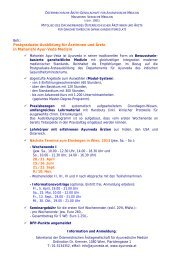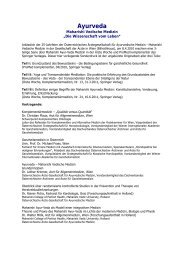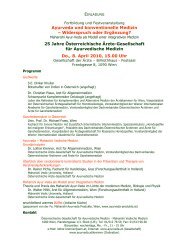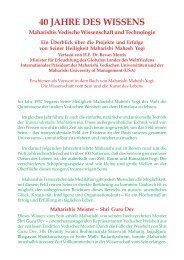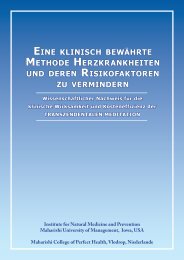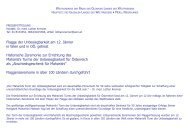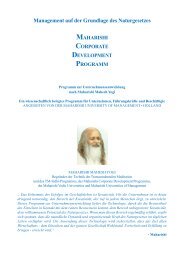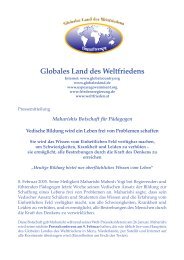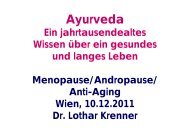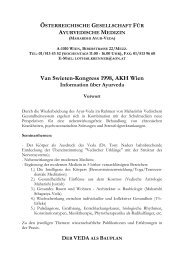Summary of Research Findings
Summary of Research Findings
Summary of Research Findings
You also want an ePaper? Increase the reach of your titles
YUMPU automatically turns print PDFs into web optimized ePapers that Google loves.
7. Title<br />
Antioxidant Properties <strong>of</strong> Two Ayurvedic Herbal Preparations [MAK-4 and MAK-5]<br />
Publication<br />
Biochemical Archives, Vol. 10, pp. 25-31, 1994.<br />
Antioxidant <strong>Research</strong> (continued)<br />
Authors<br />
Stephen C. Bondy, Tina M. Hernandez, and Cara Mattia.<br />
Conducted at<br />
Department <strong>of</strong> Community and Environmental Medicine, University <strong>of</strong> California (Irvine), Irvine, CA 92717<br />
<strong>Summary</strong><br />
Two herbal preparations (MAK-4 and MAK-5)<br />
constituted <strong>of</strong> mixtures <strong>of</strong> several plants have been used<br />
over a long period <strong>of</strong> time by practitioners <strong>of</strong> Ayurvedic<br />
medicine. In view <strong>of</strong> several reports on their healthrelated<br />
utility, this investigation was undertaken to study<br />
their properties in biological systems. Results <strong>of</strong> this<br />
study showed that ethanol and aqueous extracts <strong>of</strong> these<br />
preparations were able to quench generation <strong>of</strong> reactive<br />
oxygen species in vitro within an isolated cerebrocortical<br />
fraction enriched in mitochondria and nerve endings<br />
(synaptosomes). Both the ethanol and aqueous extracts<br />
<strong>of</strong> MAK-4 and MAK-5 exhibited potent antioxidant activity.<br />
The greatest effect was<br />
seen with the ethanol extracts <strong>of</strong> these herbal mixtures,<br />
and the most potent inhibition was found in ethanol-soluble materials derived from the MAK-5 product.<br />
The ability <strong>of</strong> MAK-5 extracts to modulate chemically-induced oxidative stress was also examined in intact<br />
animals. The excess production <strong>of</strong> reactive oxygen species observed within the cerebellar mitochondrial fraction<br />
after exposure <strong>of</strong> rats to toluene, was prevented by pretreatment with MAK-5. This effect was not apparent<br />
when the ethanol and aqueous extracts <strong>of</strong> the preparation<br />
were tested separately. However, the ethanol extract from<br />
MAK-5 alone was able to inhibit the toluene-induced elevation<br />
<strong>of</strong> oxidative species within a mitochondrial fraction derived<br />
from the kidney. The results suggest that these herballyderived<br />
mixtures possess distinctive qualities which may be <strong>of</strong><br />
utility in the design <strong>of</strong> preventive or therapeutic approaches<br />
relating to the mitigation <strong>of</strong> excess oxidative events. See<br />
<strong>Research</strong> on Reduction <strong>of</strong> Chemical Toxicity for more information<br />
on this study.<br />
Study 7 <strong>Research</strong> Highlights<br />
Ethanol and aqueous extracts <strong>of</strong> MAK-4 and MAK-5 were able to quench generation <strong>of</strong> reactive oxygen species<br />
in vitro within an isolated cerebrocortical fraction enriched in mitochondria and nerve endings. Thus, these<br />
herbally-derived mixtures possess distinctive qualities, which may be <strong>of</strong> utility in the design <strong>of</strong> preventive or<br />
therapeutic approaches related to the mitigation <strong>of</strong> excess oxidative events.<br />
27



